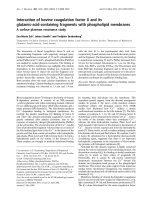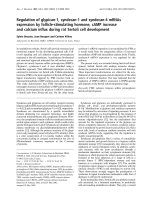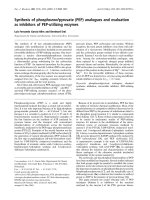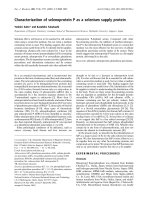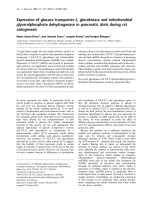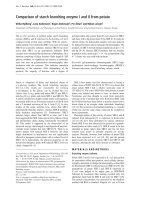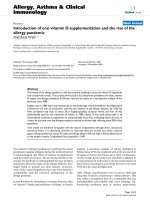Báo cáo y học: "Usefulness of N-terminal pro-brain natriuretic peptide and C-reactive protein to predict ICU mortality in unselected medical ICU patients: a prospective, observational study" pot
Bạn đang xem bản rút gọn của tài liệu. Xem và tải ngay bản đầy đủ của tài liệu tại đây (422.63 KB, 9 trang )
RESEARCH Open Access
Usefulness of N-terminal pro-brain natriuretic
peptide and C-reactive protein to predict ICU
mortality in unselected medical ICU patients:
a prospective, observational study
Feilong Wang
1†
, Wenzhi Pan
2†
, Shuming Pan
1*
, Shuyun Wang
1
, Qinmin Ge
1
, Junbo Ge
2*
Abstract
Introduction: The performance of N-terminal pro-brain natriuretic peptide (NT-proBNP) and C-reactive protein
(CRP) to predict clinical outcomes in ICU patients is unimpressive. We aimed to assess the prognostic value of NT-
proBNP, CRP or the combination of both in unselected medical ICU patients.
Methods: A total of 576 consecutive patients were screened for eligibility and followed up during the ICU stay. We
collected each patient’s baseline characteristics including the Acute Physiology and Chronic Health Evaluation II
(APACHE-II) score, NT-proBNP and CRP levels. The primary outcome was ICU mortality. Potential predictors were
analyzed for possible association with outcomes. We also evaluated the ability of NT-proBNP and CRP additive to
APACHE-II score to predict ICU mortality by calculation of C-index, net reclass ification improvement (NRI) and
integrated discrimination improvement (IDI) indices.
Results: Multiple regression revealed that CRP, NT-proBNP, APACHE-II score and fasting plasma glucose
independently predicted ICU mortality (all P < 0.01). The C-index with respect to prediction of ICU mortality of
APACHE II score (0.82 ± 0.02; P < 0.01) was greater than that of NT-proBNP (0.71 ± 0.03; P < 0.01) or CRP (0.65 ±
0.03; P < 0.01) (all P < 0.01). As compared with APACHE-II score (0.82 ± 0.02; P < 0.01), combination of CRP (0.83 ±
0.02; P < 0.01) or NT-proBNP (0.83 ± 0.02; P < 0.01) or both (0.84 ± 0.02; P < 0.0 1) with APACHE-II score did not
significantly increase C-index for predicting ICU mortality (all P > 0.05). However, addition of NT-proBNP to
APACHE-II score gave IDI of 6.6% (P = 0.003) and NRI of 16.6% (P = 0.007), addition of CRP to APACHE-II score
provided IDI of 5.6% ( P = 0.026) and NRI of 12.1% (P = 0.023), and addition of both markers to APACHE-II score
yielded IDI of 7.5% (P = 0.002) and NRI of 17.9% (P = 0.0 02). In the cardiac subgroup (N = 213), NT-proBNP but not
CRP independently predicted ICU mortality and addition of NT-proBNP to APACHE-II score obviously increased
predictive ability (IDI = 10.2%, P = 0.018; NRI = 18.5%, P = 0.028). In the non-cardiac group (N = 363), CRP rather
than NT-proBNP was an independent predictor of ICU mortality.
Conclusions: In unselected medical ICU patients, NT-proBNP and CRP can serve as independent predictors of ICU
mortality and addition of NT-proBNP or CRP or both to APACHE-II score significantly improves the ability to predict
ICU mortality. NT-proBNP appears to be useful for predicting ICU outcomes in cardiac patients.
* Correspondence: ;
† Contributed equally
1
Department of Emergency, Xinhua Hospital of Shanghai Jiaotong University,
NO.1665, Kongjiang Road, Shanghai, 200092, PR China
2
Department of Cardiology, Shanghai Institute of Cardiovascular Diseases,
Zhongshan Hospital of Fudan University, NO.180, Fenglin Road, Shanghai,
200032, PR China
Full list of author information is available at the end of the article
Wang et al. Critical Care 2011, 15:R42
/>© 2011 Wang et al.; lic ensee BioMed Central Ltd. This is an open access article distribu ted under the terms of the Creative Commons
Attribution License ( censes/by/ 2.0), which permits unrestricted use, distribution, and reproduction in
any medium, provided the original work is properly cited.
Introduction
N-terminal pro-brain natriuretic peptide (N T-proBNP)
is the inactive polypep tide of the pre-pr ohorm one brain
natriuretic peptide (BNP). It is synthesized in the cardiac
myocytes in response to hemodynamic stress [1] or
inflammatory status [2]. Over the last d ecade, some stu-
dies have indicated that NT-proBNP testing greatly
increased the accuracy of the diagnosis of heart failure
in patients with dyspnea [3,4]. NT-proBNP can also
serve a s a novel, independent predictor of prognosis i n
cardiovascular patients [5-7] as well as in the general
population [8]. During the past few years, several studies
[9-16] have focused on the potential value of NT-
proBNP for prognosis of intensive care unit (ICU)
patients, but the performance of NT-proBNP to predict
adverse out come in those patients is unimpressive [17].
First, the results of those studies have been conflicting.
Several studies have shown that NT-proBNP could serve
as an independent predictor of greater mortality in
patients with cardiogenic shock [9], septic s hock [10],
severe sepsis [11], as well asinnoncardiac[12-14]or
unselected ICU patients [15], while another study [16]
demonstrated that NT-proBNP failed to predict short-
term mortality of ICU patients with hypoxic respiratory
failure. Second, most of these studies were rather small
and confounded by some factors, such as cardiovascu lar
disease, renal insufficiency, or inflammation [17],
although the prevalence of these conditions among
patients admitted to ICU is generally high.
C-reactive protein (CRP) is an extremely sensitive
objective marker of inflammation, tissue damage, and
infection. Its ability to provide predictive value of long-
term outcomes in ICU patients was just investigated in
limited studies [18-20]. There were less data about the
predicti ve value of CRP for short-term mortality [21,22].
In addition, although NT-proBNP and CRP have been
shown to be predictors of adverse outcomes in ICU
patients, the predictive value of the combination of both
for outcomes has not been investigated.
Currently, the Acute Physiology and Chronic Health
Evaluation II (APACHE-II) score is one of the most
common models used to evaluate ICU patie nts’ condi-
tion and predict their outcomes [23]. The additive abil-
ity of NT-proBNP and CRP to APACHE-II score to
predict ICU mortality has rarely been assessed. Tradi-
tionally, predi ctive models have been evaluated by
C- statistic, but this method has been criticized as being
insensitive in comparing models [24] and for having lit-
tle direct clinical relevance [25]. Seve ral new methods
have recently been proposed to evaluate and compare
pred ictive risk models [26]. C alculation of net reclassifi-
cation improvement (NRI) and integrated discrimination
improvement (IDI) indices is now frequently being used
[27]. We hypothesized that the higher plasma level of
NT-proBNPandCRPwouldbeindependentlyasso-
ciated with worse clinical outcomes in unselected ICU
patients. We, therefore, undertook a prospective, obser-
vational study to assess the prognostic value of
NT-proBNP, CRP or combinati on of both in a large
population of unselected medical ICU patients. We also
evaluated the ability of NT-proBNP and CRP additive to
APACHE-II score to predict ICU mortality by calcula-
tion of C-index, NRI and IDI indices.
Materials and methods
Participants
The prospective, observational trial was undertaken
between January 20 09 and March 2010 at Xi nhua Hospital
Affiliated to Shanghai Jiaotong University School of Medi-
cine. Medical patients were eligible for enrollment if they
needed to be transfe rred to ICU from emergency depart-
ment or other departments of our hospital (trauma and
surgical patients were not included). The decision to trans-
fer the patients into or out of ICU was made by at least
one critical care expert and one medical expert. Exclusion
criteria were age < 18 y ears and known pregnancy. Patients
who died within four hours of admission or were dis-
charged f rom the ICU within f our hours of admission w ere
also excluded because data collection for those patients
was difficult. Patients were classified as cardiac or noncar-
diac subgroups according to their primary diagnosis.
Noncardiac was defined as a patient with a primary non-
cardiac diagnosis. Noncardiac did n ot preclude a secondary
cardiac disease, nor was a preexisting cardiac disease a
priori excluded. The study was approved by Shanghai
Jiaotong University Xinhua Hospital Ethics Committee
(XHEC2011-002) and in accordance with the Declaration
of Helsinki. Be cause this was an observa tional study and all
laboratory indices (including CRP and NT-pro-BNP)
observed were commonly measured for all patients in our
ICU department, the need for written informed consent
was waived b y the review ethical review board.
Laboratory methods
The NT-proBNP level was determined using the Ele csys
Electro-chemo luminescent assay (Cobase 411 analyzer;
Roche Diagnostics; Mannheim, Germany). The analytical
range f or NT-proBNP in the laboratory of our hospital
is 5 to 35,000 pg/mL. Readings > 35,000 pg/mL were
taken as 350,000 pg/mL. Reported total coefficient of
variation is 4.4% at mean concentration 248.9 ng/L and
3.91% at MC 5,449 ng/L, respectively, based on multi-
cent er calibrations of the automated Roche NT-proBNP
assay [28]. Serum creatinine (SCr) and albumin were
measured by the Hitachi 7600-120 (Hitachi, Tokyo,
Japan) analyzer. We calculated the estimated glomerular
filtration rate (eGFR) using the ab breviated Mod ification
of Diet in Renal Disease (MDRD) study equation: eGFR
Wang et al. Critical Care 2011, 15:R42
/>Page 2 of 9
(expressed in m L/minute/1.73 m2) = 186 * (SCr) -1.154
* (age) -0.203 *0.742 (if female), where SCr is serum
creatinine in mg/dL [29]. Serum CRP levels were mea-
sured using Quick Read CRP test kit (Orion Corpora-
tion, Orion Diagnosti ca, Espoo, Finland). Blood samples
were obtained from patients when they were admitted
to ICU for measurement of the indicators mentioned
previously.
Study outcomes
At baseline, demographic and clinical characteristics,
including the APACHE-II score (which can range from
0 to 71, with higher scores indicating more severe ill-
ness), were collected. Then the patients were followed
up during the ICU stay. The primary outcome of this
analysis was death in the ICU from any cause.
Statistical analysis
Continuous variables and categorical variables were pre-
sented as mean value ± SD and %, respectively. But
CRP, NT-proBNP and eGFR values were reported as
median (95% confidence interval) and then logarithmi-
cally normalized (presented as log-CRP, log-NT-proBNP
and log-eGFR, respectively) for statistical calculations
because they were skewed. Baseline characteristics
between survivals and non-survivals were compared
with unpaired Student’s t-test or Mann-Whitney test for
continuous variables and chi-square or Fisher’sexact
tests for categorical variables. Univariate logistic regres-
sion analyses were performed to examine the association
between mortality and each of the predictors separately.
We also conducted a forward stepwise multivariate
logistic regression to determine the independent predic-
tors of ICU mortality. A criterion of P <0.05forentry
and a P ≥ 0.10 for removal was imposed in this proce-
dure. Cox & Snell R Square and Nagelkerke R Square
were calculated for assessing the goodness of fit of the
models [30]. Odds ratios (ORs) for continuous variable s
were described using standardized ORs, which were
associated with a one standard deviation change in the
variable. The receiver operating characteristic (ROC)
curve was used to examine the performance of variables
to predict ICU mortality. The curve represented a plot
of sensitivity vs 1-specificity. The area under the curve
(AUC, that is, C-index) was calculated from the ROC
curve. A statistically derived value, based on the Youden
index, maximizing the sum of the sensitivity and specifi-
city was used to d efine the optimal cut-off value [31].
ROC curve was also constructed for the combination of
two or three variables for predicting ICU mortality
according to th e Mackinnon and Mulligan’ sweighted
sum rule [32]. The differences between AUC (C-index)
were tested by Hanley-McNeil methods in order to
examine whether the addition of one or both of the
biomarkers improved the discrimination of the model
[33]. The increased discriminative value of the biomar-
kers was further examined by calculation of NRI and
IDI indices described by Pencina et al. [27]. NRI is the
net increase versus decrease in risk categories among
case patients minus that among control participants. It
requires that there exist apriorimeaningful risk cate-
gories (we used < 10%, 10% to 30%, and 30% to 50%,
and > 50% for the risk of ICU death) [26]. IDI is the dif-
ference in Yates slopes between models, in which the
Yates slope is the mean difference in predicted probabil-
ities between case patients and control participants [26].
A two-sided P-value of less than 0.05 was considered to
indicate statistical significa nce. All analyses were p er-
formed with SPSS 13.0 software (SPSS Inc., Chicago,
Illinois, USA).
Results
Baseline characteristics
In all, 576 consecutive patients (55.7% male; mean age
71.16 ± 16.5 years) were screened for eligibility. Baseline
clinical and laboratory characteristics of the patients
were shown in Table 1. For the full population, the
median level of NT-proBNP, CRP and eGFR on ad mis-
sion was 2,922 (103 to 35,000.00) pg/ml, 39.8 (7.9 to
158.5) mg/L and 58.0 (6.5 to 150.0) mL/minute/1.73m
2
,
respectively. The mean APACHE-Ⅱ scor e was 13.6 ± 7.1
points. The primary reasons for ICU admiss ion were
cardiovascular disease and pulmonary disease. A total of
41.9% of the patients had accompanying infections.
A total of 131 (22.7%) patients died during the ICU hos-
pitalization. Non-survivors were older and in a more
severe condition as reflected by the higher APACHE-II
score, were more frequently septic or infectious, had
higher NT-proBN P, CRP, fasting plasma glucose, white
blood cell and heart rate, and had lower eGFR and
blood pressure on admission in the ICU as compared
with survivors (Table 1).
Predictors of ICU mortality
Univariate logistic regression analysis demonstrated that
those older, with higher level of NT-proBNP, CRP and
fasting plasma glucose, higher APACHE-II score and
lower eGFR had significantly greater hazard of death
(Table 2) (Because blood pressure, heart rate, white
blood cell counts and hemoglobin levels had been
included in APACHE-II score, they did not enter into
the analysis). When all the observed baseline vari ables
(Table 2) were included in a stepwise multiple logistic
model in which ICU mortality was the dependent vari-
able; only CRP, log-NT-proBNP, APACHE-II score and
fasting plasma glucose could independently predict pri-
mary outcome (P = 0.032, 0.011, 0.000 and 0.039,
receptively).
Wang et al. Critical Care 2011, 15:R42
/>Page 3 of 9
Value for CRP and NT-proBNP in prediction of ICU
mortality
To evaluate the value for the above independent vari-
ables to predict ICU mortality, ROC curves were drawn
(Figure 1). The AUC was calculated as 0.82 ± 0.02 (P <
0.01) for APACHE II score, 0.71 ± 0.03 (P <0.01)for
NT-proBNP and 0.65 ± 0.03 (P <0.01)forCRP.The
AUC of NT-proBNP or CRP was lower than that of
APACHE II score (all P < 0.01). The optimal cutoff
value of APACHE II score for predicting death was ≥
15, which gave sensitivity of 77.3% and specificity of
72.5%, and of NT-proBNP was ≥ 4,750 ng/ml, which
provided sensitivity of 69.5% and specificity of 68.8%.
The o ptimal cutoff value of CRP (≥ 27 mg/L) provided
sensitivity of 75.05% and specificity of 49.5%.
Table 1 Baseline clinical and laboratory characteristics of subjects
All Survivors Non-survivors P-value
Patients, No. 576 445 131 /
Male (%) 55.7 57.8 58.0 1.000
Age (years) 71.5 ± 16.5 70.5 ± 16.0 74.9 ± 14.3 0.004
Principal diagnosis leading to ICU admission (%)
Pulmonary disease 32.4 35.1 23.7 0.015
Cardiovascular disease 36.9 37.8 34.3 0.537
Neurologic disease 7.1 6.1 10.7 0.082
Digestive disease 5.6 6.1 3.8 0.391
Renal insufficiency 1.9 2.2 0.7 0.270
Poisoning 3.3 3.8 1.5 0.470
Infectious disease/sepsis 5.6 2.7 15.2 < 0.001
Other 7.1 6.3 9.9 0.175
Hypertension (%) 58.0 58.7 55.7 0.548
Diabetes mellitus (%) 25.9 24.7 29.8 0.257
Accompanying infection (%) 41.9 42.9 45.0 0.035
Systolic pressure (mmHg) 124.9 ± 22.4 127.4 ± 21.2 116.8 ± 24.7 < 0.001
Diastolic pressure (mmHg) 68.0 ± 12.2 69.3 ± 11.6 63.9 ± 13.3 < 0.001
Heart rate (bpm) 91.0 ± 20.5 89.2 ± 19.1 97.3 ± 24.0 < 0.001
Fasting plasma glucose (mmol/L) 11.4 ± 6.3 7.12 ± 2.9 8.5 ± 4.3 < 0.001
White blood cell (10
9
/L) 7.4 ± 3.4 10.8 ± 5.6 13.5 ± 7.9 < 0.001
Hemoglobin (g/L) 116.3 ± 25.4 118.7 ± 24.0 108.1 ± 28.1 < 0.001
eGFR(mL/min/1.73 m
2
) 58.0 (6.5 to 150.0) 62.6 (14.5 to 30.2) 34.8 (8.2 to 108.7) < 0.001
APACHE-II score (points) 13.6 ± 7.1 11.7 ± 5.6 19.9 ± 7.5 < 0.001
NT-proBNP (ng/ml) 2,922 (103 to 35,000) 5,996 (6 to 35,000) 12,726 (59 to 35,000) < 0.001
CRP(mg/L) 39.8 (7.9 to 158.5) 56.7 (1.0 to 160.1) 85.9 (6.0 to 160.2) < 0.001
APACHE II score, Acute Physiology and Chro nic Health Evaluation II score; CRP, C-reactive protein; eGFR, estimated glomerular filtration rate; NT-proBNP,
N-7terminal pro-brain natriuretic peptide.
Table 2 Univariate odds ratios of variables for predicting
ICU mortality
Predictor Odds ratio 95% CI P
Age 1.430 1.154 to 1.772 0.001
Sex / / 0.992
Log-NT-proBNP 2.202 1.728 to 2.807 < 0.001
Fasting plasma glucose 1.445 1.201 to 1.741 < 0.001
APACHE-II score 4.359 3.301 to 5.756 < 0.001
Log-eGFR 0.362 0.276 to 0.476 < 0.001
Log-CRP 1.768 1.439 to 2.173 < 0.001
Odds ratios for continuous variables shown as standardized odds ratios (OR
per 1 SD). Log-variable is the logarithm of the variable. APACHE II score, Acute
Physiology and Chronic Health Evaluation II score; CRP, C-reactive protein; NT-
proBNP, eGFR, estimated glomerular filtration rate; N-terminal pro-brain
natriuretic peptide.
Figure 1 ROC curves for APACHE II score, CRP and NT-proBNP
in prediction of ICU mortality. The area under the ROC curve
(AUC) of NT-proBNP were larger than that of CRP or NT-proBNP (all
P < 0.01).
Wang et al. Critical Care 2011, 15:R42
/>Page 4 of 9
Combination of CRP or NT-proBNP or both with APACHE
II score for predicting ICU mortality
TofurtherclarifywhetherCRPorNT-proBNPorthe
combination of both had an additive power with
APACHE-II score for predicting ICU mortality, we com-
bined one or two biomarkers with the APACHE-II score
to construct new ROC curves (Figure 2). As compared
with the APACHE-II score (AUC 0.82 ± 0.02), combina-
tion of CRP (AUC 0.83 ± 0.02) or NT-proBNP (AUC
0.83 ± 0.02) or both (AUC 0. 84 ± 0.02) with the
APACHE-II score did not signi ficantly increase AUC for
predicting ICU mortality (P = 0.74, 0.74 and 0.47, respec-
tively). The combination of CRP and NT-proBNP (AUC
0.72 ± 0.03) was inferior to APACHE-II score for predict-
ing ICU mortality (P < 0.01). In addition, the forward
stepwise logistic regression showed that the addition of
NT-proBNP or both biomarkers to the APACHE-II score
slightly increased the ability of the model to predict ICU
mortality. The Cox & Snell R Square and Nagelkerke R
Square in the model were slightly increased. (Table 3)
However, when using new statistical analysis methods
(NRI and IDI indices) which are more sensitive than the
above statistics, we found that the addition of NT-
proBNP or CRP or both to the APACHE-II score signifi-
cantly improved the ability to predict the outcome (Table
4). The addition of NT-proBNP t o he APACHE-II score
gave an IDI of 6.6% (P = 0.003) and NRI of 16.6% (P =
0.007). The addition of CRP to the APACHE-II score
provided an IDI of 5.6% (P = 0.026) and NRI of 12.1% (P
= 0.023), and the addition of both markers to the
APACHE-II score yielded an IDI of 7.5% (P =0.002)and
NRI of 17.9% (P = 0.002).
Subgroups analysis
In the non-cardiac subgroup (N = 363), the AUC with
respect to the prediction of ICU mor tality was 0.82 ±
0.03 (P < 0.01) for the APACHE II score, 0.70 ± 0.03 (P
< 0.01) for NT-proBNP and 0.64 ± 0.04 (P < 0.01) for
CRP. The AUC of the APACHE II score was larger than
that of NT-proBNP or CRP (P < 0.01). Multiple logistic
regression showed that CRP and APACHE-II scores
were independent predictors of ICU mortality ( all P <
0.01;Table5).However,theadditionofCRPtothe
APACHE-II score in the model just slightly increased
Cox & Snell R Square and Nagelkerke R Square (Table
5), and did not improve the AUC (0. 82 ± 0.03 vs 0.83
±0.03,P = 0.82). The IDI (2.89%, Z = 0.9 1, P = 0.33)
and NRI (6.36%, Z = 1.15, P = 0.25) were also not statis-
tically significant. In the cardiac subgroup (N = 213), the
AUC with respect to the prediction of ICU mortality
was cal culated as 0.81 ± 0.03 (P <0.01)forthe
APACHE II score, 0.77 ± 0.04 (P < 0.01) for NT-
proBNP and 0.69 ± 0.04 (P <0.01)forCRP.TheAUC
of the APACHE-II score was not different from that of
NT-proBNP (P = 0.42), while the AUC of both was
lager than that of CRP (P < 0.01). Multiple logistic
regression analysis demonstrated that NT-proBNP and
the APACHE-II score were independent predictors of
ICU mortality (all P < 0.01; Table 6). The addition o f
NT-proBNP to the APACHE-II score can obviously
increase Cox & Snell R Square and Nagelkerke R Square
(Table 6). Although the AUC i ncreased (0.82 ± 0.03 vs
0.86 ± 0.03, P = 0.35) insignificantly, the IDI (10.2%, Z
=2.55,P = 0.018) and NRI (18.5%, Z = 2. 20, P =0.028)
were statistically significant.
Discussion
In this large scale study of 576 unse lecte d medical ICU
patients, we found that NT-proBNP and CRP indepen-
dently predicted ICU mortality even after adjustment for
the APACHE II score and multiple potential confoun-
ders including eGFR, age, and so on. Although the pre-
dictive ability was lower as compared with the APACHE
II score, the addition of CRP or NT-proBNP or both to
the APACHE II score could significantly improve the
ability to predict ICU mortality, as demonstrated by IDI
and NRI indices. NT-proBNP appeared to be more use-
ful for predicting ICU outcomes in cardiac patients. To
our knowledge, this is the first large-scale study to eval -
uate the ability of NT-proBNP and CRP added to the
APACHE-II score to predict ICU mortality, especiall y
using the new statistics method, that is, the NRI and
IDI indices.
BNP and NT-proBNP have b ecome promising bio-
markers recently. They have been used as tools for risk
stratificat ion in car diac patients [3-7], the general popu-
lation [8] and ICU patients [9-18]. Most of the studies
investigating the predictive value of NT-proBNP in ICU
patients were confounded by some facto rs, such as renal
insufficiency or inflammation. Our study showed that
Figure 2 ROC curves for combination of two or three variables
among CRP, NT-proBNP and APACHE-II score. Combination of
CRP or NT-proBNP or both with APACHE-II score did not
significantly increase AUC with regard to perdition of ICU mortality
(all P > 0.05). Combination of CRP and NT-proBNP was inferior to
APACHE-II score alone for predicting ICU mortality (P < 0.01).
Wang et al. Critical Care 2011, 15:R42
/>Page 5 of 9
NT-proBNP independently predicted ICU mortality in
unselected patients even after adjustment for the
APACHE II score and other potential confounders,
including age, renal insufficiency (eGFR), and inflamma-
tion (CRP). However, the ability of NT-proBNP to pre-
dict ICU mortality was lower than that of the APACHE
II score (AUC: 0.82 ± 0.02 vs 0.71 ± 0.03, P < 0.01; OR:
1.454 vs 3.532). The C statistic is the most commonly
used method of determining model discrimination. In
this method, we found that the additio n of one or both
the biomarkers to the APACHE II score did not signifi-
cantly improve the predictive ability (AUC). However,
the sole reliance on the C-statistic for the evaluation of
predictors has been questioned, because very large inde-
pendent associations of a new marker with t he outcome
are r equired to result in a significant increase in the C
statistic [24,25]. In the present study, we also used a
more sensitive test of improvement in model discrimi-
nation [27]. We found that the addition of NT-proBNP
to the APACHE II score significantly increased the abil-
ity to predict ICU mortality as demonstrated by the IDI
(6.6%, P = 0.003) and NRI (16.6%, P = 0.007) indices.
NT-proBNP was not an independent predictor of ICU
mortality in the non-cardiac subgroup after adjustment
for APACHE II score and CRP. Kotanidou et al.[13]
found that NT-proBNP predicted mortality indepen-
dently after the adjusted APACHE II score and some
inflammatory cytokines levels in non-cardiac ICU
patients. But they used TNF-a, IL-6, and IL-10 rather
than CRP and enroll ed many surgical and multiple
trauma cases. In the cardiac subgroup, NT-proBNP
independently predicted ICU mortality while the AUC
of the APACHE II score was not different from that of
NT-proBNP (0.81 ± 0.03 vs 0.77 ± 0.04; P > 0.05). The
addition of NT-proBNP to the APACHE-II score can
obviously increase predictive ability (IDI = 10.2%, P =
0.018; NRI = 18.5%, P = 0.028). Therefore, although
NT-proBNP could predict ICU mortality in unselected
medical patents, it appeared to be more useful in cardiac
patients than in non-cardiac patients.
LV wall tension is regarded as the primary mechanism
regulating NT-proBNP secretion [1]. Other hemody-
namic factors that may contribute to NT-proBNP secre-
tion include left ventric ular diastolic dysfunction and
right ventricular overload and dysfunction [10,34].
Other mechanisms proposed to account for high
NT-proBNP values include renal dysfunction [35] and
inflammatory status [36,37]. Therefore, patients w ith
high NT-proBNP may have cardiac dysfunction, renal
dysfunction or inflammatory status. All of these factors
have shown to be a frequent and important factors in
determining the outcome of critically ill patients
[18-21,38]. This is t he reason why N T-proBNP can be
used as a predictor of outcomes in ICU patients.
CRP has long been considered to be a distinct and
sensi tive biomarker of inflammation, tissue damage, and
infection. Some studies also suggest that CRP may be an
indicator of or gan failure [22]. Only a f ew studies h ave
tested its value for predicting outcome in ICU patients
[18-22]. However, most of these studies observed the
post-ICU outcomes but not ICU mortality. NT-proBNP
was not included in thei r analyses, either. One previous
study showed no predictive value of CRP for in- hospital
mortality, even in univariate analysis [21]. The scope of
the study was rather small (N = 103) and, thus, the sta-
tistical power was less than that of our study. Moreover,
Table 4 Independent predictors of ICU mortality by multivariate logistic regression in all patients (appending models
summary)
OR OR-st P -2 Log likelihood Cox & Snell R Square Nagelkerke R Square
Model I APACHE-II score 1.225 4.359 0.000 467.269 0.215 0.328
Model II Log-NT-proBNP 1.633 1.454 0.008 458.360 0.228 0.346
APACHE-II score 1.196 3.532 0.000
Model III Log-CRP 1.778 1.355 0.017
Log-NT-proBNP 1.628 1.448 0.011 452.586 0.236 0.358
APACHE-II score 1.183 3.225 0.000
APACHE II score, Acut e Physiology and Chronic Health Evaluation II score; CRP, C-reactive protein; eGFR, estimated glomerular filtration rate; OR, odds ratio; OR-st,
standardized Odds ratios (OR per 1 SD); NT-proBNP, N-terminal pro-brain natriuretic peptide.
Table 3 NRI and IDI for assessing improvement in model performance after adding biomarkers to APACHE-II score
NRI Z value for NRI P-value for NRI IDI Z value for NRI P-value for NRI
APACHE-II score + log(NT-proBNP) 16.6% 2.982 0.003 6.6% 2.680 0.007
APACHE-II score + log(CRP) 12.1% 2.216 0.026 5.6% 2.267 0.023
APACHE-II score + log(NT-proBNP) +log(CRP) 17.9% 3.042 0.002 7.5% 3.036 0.002
APACHE II score, Acute Physiology and Chro nic Health Evaluation II score; CRP, C-reactive protein; eGFR, estimated glomerular filtration rate; IDI, integrated
discrimination improvement; NRI, Net reclassification improvement; N-terminal pro-brain natriuretic peptide; NT-proBNP
Wang et al. Critical Care 2011, 15:R42
/>Page 6 of 9
the endpoint of the previous study was in-hospital mor-
tality but not ICU mortality. The present study revealed
that CRP was also a n independent predictor of ICU
mortality in unselec ted patients or non-cardiac patients.
Although the C-statistic showed the addition of CRP to
the APACHE-II score in prediction of ICU mortality did
not significantly improve the predictive ability, NRI
(12.1%, P = 0.026) and IDI (5.6%, P = 0.023) were statis-
tically significant.
Several limitations of our study should be mentioned.
First, neither echocardiography was performed nor cardiac
function assessed in the present study . The div ision of sub-
groups was according to primary admission cause. Thus
patients in the non-cardiac group may also have cardiac
disease and cardiac dysfunction. However, patients with
cardiac diseases as the primary principal diagnosis leading
to ICU admission must have cardiac diseases. The statisti-
cal conclusion drawn from th e cardiac group was appropri-
ate. S e cond, this was a sin gle-center study, and p articipants
did not include surgery and trauma patients. The value for
NT-proBNP in prediction of adverse outcome would be a
bit different if the population was different. At last, a lim-
itation of the net reclassification improv ement and other
reclassification measures is that they depend on the parti-
cular categories used [26]. We had used < 10%, 10% to
30%, and 30% to 50%, and > 50% for the risk of ICU death
as risk categories. B ut there are still no w e ll-recognized risk
categories now. If the risk categories used had been differ-
ent, the NRI would be a bit different.
Conclusions
In this large-scale study of unselected ICU patients, we
confirmed that NT-proBNP and CRP can serve as mod-
erate independent predictors of ICU mortality. Although
the predictive ability was lower compared with the
APACHE II score, but the addition of CRP or
NT-proBNP or both to the APACHE II score could sig-
nificantly improve the ability to predict ICU mortality,
as demonstrated by IDI and NRI indices. NT-proBNP
appeared to be more useful for predicting ICU out-
comes in cardiac patients.
Key messages
● NT-proBNP and CRP independently predicted ICU
mortality even after adjustment for the APACHE II
score and multiple potential confounders.
● The ability of NT-proBNP and CRP to predict
ICU mortality was lower compared with the
APACHE II score.
● The addition of CRP or NT-proBNP or both to
the APACHE II score could significantly improve
the ability to predict ICU mortality as demonstrated
by IDI and NRI indices.
● NT-proBNPappearedtobemoreusefulforpre-
dicting ICU outcomes in cardiac patients.
Abbreviations
AUC: area under the curve; APACHE-II: score, Acute Physiology and Chronic
Health Evaluation II score; BNP: brain natriuretic peptide; CRP.: -reactive
protein; eGFR,: estimated glomerular filtration rate; ICU: intensive care unit;
IDI: integrated discrimination improvement; MCV: mean corpuscular volume;
MDRD: Modification of Diet in Renal Disease; NRI: net reclassification
improvement; OR: odds ratio; RDW: red blood cell distribution width; ROC:
curve, receiver operating characteristic curve; SCr: serum creatinine.
Author details
1
Department of Emergency, Xinhua Hospital of Shanghai Jiaotong University,
NO.1665, Kongjiang Road, Shanghai, 200092, PR China.
2
Department of
Cardiology, Shanghai Institute of Cardiovascular Diseases, Zhongshan
Hospital of Fudan University, NO.180, Fenglin Road, Shanghai, 200032, PR
China.
Table 6 Independent predictors of ICU mortality by multivariate logistic regression in cardiac patients (appending
models summary)
OR OR-st P -2 Log likelihood Cox & Snell R Square Nagelkerke R Square
Model I APACHE-II score 1.265 4.371 0.000 167.854 0.201 0.311
Model II Log-NT-proBNP 3.356 2.296 0.002 157.161 0.241 0.373
APACHE-II score 1.226 3.618 0.000
APACHE II score, Acute Physiology and Chro nic Health Evaluation II score; CRP, C-reactive protein; eGFR, estimated glomerular filtration rate; NT-proBNP, N-
terminal pro-brain natriuretic peptide; OR, odds ratio; OR-st, standardized Odds ratios (OR per 1 SD).
Table 5 Independent predictors of ICU mortality by multivariate logistic regression in non-cardiac patients (appending
models summary)
OR OR-st P -2 Log likelihood Cox & Snell R Square Nagelkerke R Square
Model I APACHE-II score 1.207 3.987 0.000 295.870 0.230 0.346
Model II Log-CRP 2.056 1.451 0.002 290.175 0.242 0.365
APACHE-II score 1.198 3.781 0.000
OR, odds ratio; OR-st, standardized Odds ratios (OR per 1 SD); APACHE II score, Acute Physiology and Chronic Health Evaluation II score; eGFR, estimated
glomerular filtration rate; CRP, C-reactive protein; NT-proBNP, N-terminal pro-brain natriuretic peptide.
Wang et al. Critical Care 2011, 15:R42
/>Page 7 of 9
Authors’ contributions
WeP and JG participated in the design of the study and performed the
statistical analysis and drafted the manuscript. FW and SP carried out data
collection, contributed to the design of the study and helped to draft the
manuscript. QG and SW participated in the data collection. All authors read
and approved the final manuscript.
Competing interests
The authors declare that they have no competing interests.
Received: 3 November 2010 Revised: 13 January 2011
Accepted: 28 January 2011 Published: 28 January 2011
References
1. Daniels LB, Maisel AS: Natriuretic peptides. J Am Coll Cardiol 2007,
50:2357-2368.
2. Ma KK, Ogawa T, de Bold AJ: Selective upregulation of cardiac brain
natriuretic peptide at the transcriptional and translational levels by pro-
inflammatory cytokines and by conditioned medium derived from
mixed lymphocyte reactions via p38 MAP kinase. J Mol Cell Cardiol 2004,
36:505-513.
3. Januzzi JL Jr, Camargo CA, Anwaruddin S, Baggish AL, Chen AA,
Krauser DG, Tung R, Cameron R, Nagurney JT, Chae CU, Lloyd-Jones DM,
Brown DF, Foran-Melanson S, Sluss PM, Lee-Lewandrowski E,
Lewandrowski KB: The N-terminal Pro-BNP Investigation of Dyspnea in
the Emergency Department (PRIDE) study. Am J Cardiol 2005, 95:948-954.
4. Moe GW, Howlett J, Januzzi JL, Zowall H: N-terminal pro-B-type natriuretic
peptide testing improves the management of patients with suspected
acute heart failure: primary results of the Canadian prospective
randomized multicenter IMPROVE-CHF study. Circulation 2007,
115:3103-3110.
5. Masson S, Latini R, Anand IS, Vago T, Angelici L, Barlera S, Missov ED,
Clerico A, Tognoni G, Cohn JN, Val-HeFT Investigators: Direct comparison
of B-type natriuretic peptide (BNP) and amino-terminal pro-BNP in a
large population of patients with chronic and symptomatic heart failure:
the Valsartan Heart Failure (Val-HeFT) data. Clin Chem 2006, 52:1528-1558.
6. Omland T, Sabatine MS, Jablonski KA, Rice MM, Hsia J, Wergeland R,
Landaas S, Rouleau JL, Domanski MJ, Hall C, Pfeffer MA, Braunwald E, PEACE
Investigators: Prognostic value of B-type natriuretic peptides in patients
with stable coronary artery disease: the PEACE trial. J Am Coll Cardiol
2007, 50:205-214.
7. Galvani M, Ottani F, Oltrona L, Ardissino D, Gensini GF, Maggioni AP,
Mannucci PM, Mininni N, Prando MD, Tubaro M, Vernocchi A, Vecchio C,
Italian Working Group on Atherosclerosis Thrombosis and Vascular Biology
and the Associazione Nazionale Medici Cardiologi Ospedalieri (ANMCO): N-
terminal pro-brain natriuretic peptide on admission has prognostic
value across the whole spectrum of acute coronary syndromes.
Circulation 2004, 110:128-134.
8. Wang TJ, Larson MG, Levy D, Benjamin EJ, Leip EP, Omland T, Wolf PA,
Vasan RS: Plasma natriuretic peptide levels and the risk of cardiovascular
events and death. N Engl J Med 2004, 350:655-663.
9. Januzzi JL, Morss A, Tung R, Pino R, Fifer MA, Thompson BT, Lee-
Lewandrowski E: Natriuretic peptide testing for the evaluation of critically
ill patients with shock in the intensive care unit: a prospective cohort
study. Crit Care 2006, 10:R37.
10. Roch A, Allardet-Servent J, Michelet P, Oddoze C, Forel JM, Barrau K,
Loundou A, Perrin G, Auffray JP, Portugal H, Papazian L: NH2 terminal pro-
brain natriuretic peptide plasma level as an early marker of prognosis
and cardiac dysfunction in septic shock patients. Crit Care Med 2005,
33:1001-1007.
11. Varpula M, Pulkki K, Karlsson S, Ruokonen E, Pettila V: Predictive value of N-
terminal pro-brain natriuretic peptide in severe sepsis and septic shock.
Crit Care Med 2007, 35:1277-1283.
12. Shah KB, Nolan MM, Rao K, Wang DJ, Christenson RH, Shanholtz CB,
Mehra MR, Gottlieb SS: The characteristics and prognostic importance of
NT-ProBNP concentrations in critically ill patients. Am J Med 2007,
120:1071-1077.
13. Kotanidou A, Karsaliakos P, Tzanela M, Mavrou I, Kopterides P,
Papadomichelakis E, Theodorakopoulou M, Botoula E, Tsangaris I, Lignos M,
Ikonomidis I, Ilias I, Armaganidis A, Orfanos SE, Dimopoulou I: Prognostic
importance of increased plasma amino-terminal pro-brain natriuretic
peptide levels in a large noncardiac, general intensive care unit
population. Shock
2009, 31:342-347.
14.
Almog Y, Novack V, Megralishvili R, Kobal S, Barski L, King D, Zahger D:
Plasma level of N terminal pro-brain natriuretic peptide as a prognostic
marker in critically ill patients. Anesth Analg 2006, 102:1809-1815.
15. Meyer B, Huelsmann M, Wexberg P, Delle Karth G, Berger R, Moertl D,
Szekeres T, Pacher R, Heinz G: N-terminal pro-B-type natriuretic peptide is
an independent predictor of outcome in an unselected cohort of
critically ill patients. Crit Care Med 2007, 35:2268-2273.
16. Jefic D, Lee JW, Je fic D, Savoy-Moore RT, Rosman HS: Ut il ity of B-type natriuretic
peptide a nd N-terminal pro B-type natriuretic peptide in evaluation of
respiratory failure in criticall y ill patients. Ch est 2005, 128:288-295.
17. Christenson RH: What is the value of B-type natriuretic peptide testing
for diagnosis, prognosis or monitoring of critically ill adult patients in
intensive care? Clin Chem Lab Med 2008, 46:1524-1532.
18. Ho KM, Lee KY, Dobb GJ, Webb SA: C-reactive protein concentration as a
predictor of in-hospital mortality after ICU discharge: a prospective
cohort study. Intensive Care Med 2008, 34:481-487.
19. Litton E, Ho KM, Chamberlain J, Dobb GJ, Webb SA: C-reactive protein
concentration as a predictor of in-hospital mortality after ICU discharge:
a nested case-control study. Crit Care Resusc 2007, 9:19-25.
20. Grander W, Dünser M, Stollenwerk B, Siebert U, Dengg C, Koller B, Eller P,
Tilg H: C-Reactive Protein Levels and Post-ICU Mortality in Nonsurgical
Intensive Care Patients. Chest 2010, 138:856-862.
21. Schuetz P, Müller B, Nusbaumer C, Wieland M, Christ-Crain M: Circulating
levels of GH predict mortality and complement prognostic scores in
critically ill medical patients. Eur J Endocrinol 2009, 160:157-163.
22. Lobo SM, Lobo FR, Bota DP, Lopes-Ferreira F, Soliman HM, Mélot C,
Vincent JL: C-reactive protein levels correlate with mortality and organ
failure in critically ill patients. Chest 2003, 123:2043-2049.
23. Knaus WA, Draper EA, Wagner DP, Zimmerman JE: APACHE II: a severity of
disease classification system. Crit Care Med 1985, 13:818-829.
24. Pepe MS, Janes H, Longton G, Leisenring W, Newcomb P: Limitations of
the odds ratio in gauging the performance of a diagnostic, prognostic,
or screening marker. Am J Epidemiol 2004, 159:882-890.
25. Janes H, Pepe MS, Gu W: Assessing the value of risk predictions by using
risk stratification tables. Ann Intern Med 2008, 149:751-760.
26. Cook NR, Ridker PM: Advances in measuring the effect of individual
predictors of cardiovascular risk: the role of reclassification measures.
Ann Intern Med 2009, 150:795-802.
27. Pencina MJ, D’Agostino RB Sr, D’Agostino RB Jr, Vasan RS:
Evaluating the
added
predictive ability of a new marker: from area under the ROC
curve to reclassification and beyond. Stat Med 2008, 27:157-172.
28. Yeo KT, Wu AH, Apple FS, Kroll MH, Christenson RH, Lewandrowski KB,
Sedor FA, Butch AW: Multicenter evaluation of the Roche NT-proBNP
assay and comparison to the Biosite Triage BNP assay. Clin Chim Acta
2003, 338:107-115.
29. National Kidney Foundation: K/DOQI clinical practice guidelines for
chronic kidney disease: evaluation, classification, and stratification. Am J
Kidney Dis 2002, 39:S1-S266.
30. Nagelkerke N: A note on a general definition of the coefficient of
determination. Biometrika 1991, 78:691-692.
31. Youden WJ: Index for rating diagnostic tests. Cancer 1950, 3:32-35.
32. Mackinnon A, Mulligan R: Combining cognitive testing and informant
report to increase accuracy in screening for dementia. Am J Psychiatry
1998, 155:1529-1535.
33. Hanley JA, McNeil BJ: A method of comparing the areas under ROC
curves derived from same cases. Radiology 1983, 148:839-843.
34. Chua G, Kang-Hoe L: Marked elevations in N-terminal brain natriuretic
peptide levels in septic shock. Crit Care 2004, 8:R248-250.
35. McCullough PA, Duc P, Omland T, McCord J, Nowak RM, Hollander JE,
Herrmann HC, Steg PG, Westheim A, Knudsen CW, Storrow AB,
Abraham WT, Lamba S, Wu AH, Perez A, Clopton P, Krishnaswamy P,
Kazanegra R, Maisel AS, Breathing Not Properly Multinational Study
Investigators: B-type natriuretic peptide and renal function in the
diagnosis of heart failure: an analysis from the Breathing Not Properly
Multinational Study. Am J Kidney Dis 2003, 41:571-579.
Wang et al. Critical Care 2011, 15:R42
/>Page 8 of 9
36. Harada E, Nakagawa O, Yoshimura M, Harada M, Nakagawa M, Mizuno Y,
Shimasaki Y, Nakayama M, Yasue H, Kuwahara K, Saito Y, Nakao K: Effect of
interleukin-1 beta on cardiac hypertrophy and production of natriuretic
peptide in rat cardiocyte culture. J Mol Cell Cardiol 1999, 31:1997-2006.
37. Rudiger A, Fischler M, Harpes P, Gasser S, Hornemann T, von Eckardstein A,
Maggiorini M: In critically ill patients, B-type natriuretic peptide (BNP)
and N-terminal pro-BNP levels correlate with C-reactive protein values
and leukocyte counts. Int J Cardiol 2008, 126:28-31.
38. Ammann P, Fehr T, Minder EI, Günter C, Bertel O: Elevation of troponin I in
sepsis and septic shock. Intensive Care Med 2001, 27:965-969.
doi:10.1186/cc10004
Cite this article as: Wang et al.: Usefulness of N-terminal pro-brain
natriuretic peptide and C-reactive protein to predict ICU mortality in
unselected medical ICU patients: a prospective, observational study.
Critical Care 2011 15:R42.
Submit your next manuscript to BioMed Central
and take full advantage of:
• Convenient online submission
• Thorough peer review
• No space constraints or color figure charges
• Immediate publication on acceptance
• Inclusion in PubMed, CAS, Scopus and Google Scholar
• Research which is freely available for redistribution
Submit your manuscript at
www.biomedcentral.com/submit
Wang et al. Critical Care 2011, 15:R42
/>Page 9 of 9


